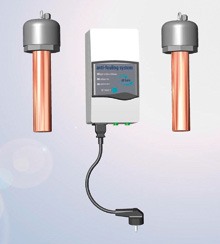4 Types of Anti-fouling Systems Used on Board Ships to Prevent Marine Growth
Biofouling is one of the main problems faced by every type of ship at the sea. Marine growth such as barnacles and mussels have been the reason for problems such as decreased ship efficiency, corrosion etc.
Biofouling not only sticks to the external surface of the ships but also gets into the water intakes and sticks to the surface of the pipes leading to problems such as blockage and corrosion.

Though mechanical removing tools can be used to get rid of such marine growth, this is not always possible. For this reason, different types of marine growth prevent systems are used on board ships, along with anti-fouling paints.
The main types of preventive measures used on ships are:
- Electrolytic system
- Chemical dosing
- Ultrasonic system
- Electro-chlorination
1. Electrolytic system
This is one of the most commonly used systems to fight biofouling on ships.
The electrolytic system consists of pairs of anodes, mostly copper and aluminum (or iron). The anodes are mounted in the sea chest or the strainer.

DC current is passed through the copper anodes, which produce ions that are carried with the seawater in the whole piping network. These copper ions in the seawater prevent marine organisms from settling down and multiplying on the surface of the pipes.
The second anode is used to prevent corrosion of the metal surface. The iron anodes help in preventing layers of oxide films of the metals from breaking down by the corrosive agents (sulphur) of seawater. This system also gives protection to valves, condensers, engine cooling systems and ancillary equipment.
A control panel measures and monitors the output of each of the anodes.
2. Chemical Dosing
Chemical dosing is also a common method which is used to prevent marine growth in piping network. Anti-fouling chemical such as ferrous chloride is used to dose sea water boxes. The chemical coats the pipework with a protective ferrous layer to prevent corrosion.
3. Ultrasonic
High frequency waves are also used as a method to prevent marine growth in piping systems. Ultrasonic system is supposed to be known as one of the most highly effective methods to prevent biofouling. A reduction in biofouling of as much as 80% is claimed by this method.

According to research, ultrasonics is supposed to have two types of effects on anti-fouling.
- A disturbance action because of the high frequency waves which renders the habitat unacceptable
- A mechanical action on the organisms which are trying to deposit adhesive. It not only helps in preventing it from solidifying but also acts on 4-5mm organisms which are already anchored.
In the ultrasonic method, a wave generator produces and sends electrical impulses at high frequency. These waves are passed through a coaxial cable to transducers which are mounted externally to the sea chests or strainers.
The transducers contain piezoelectric ceramic crystals, which when excited by electrical impulses, generate an ultrasonic beam.
The main advantage of this system is that it is non-invasive and no parts are in contact with sea water. Moreover, no toxic substances are produced.
4. Electro-chlorination
Electro-chlorination is a method in which chlorine is generated to produce sodium hypochlorite, which is used to prevent fouling.

Titanium is used as the cathode material whereas titanium coated with 100 micro-inches of platinum is used as anodes. Titanium is an electrochemically inert element at positive voltages less than 9 volts. The anode/cathode voltage is kept 7 volts.
Chlorine is generated at the anodes along with other elements to form sodium hyperchlorite. A large amount of hydrogen gas is also produced which should be evacuated safely.
The layer at the anode in consumed at a rate of 6 mg/ampere per year. However, it depends on the unit voltages and currents supplied. The total output of chlorine is a function of current rather than flow through the unit. Thus adequate flow is required to ensure cooling and to prevent calcareous deposits.
10pp chlorine in sea water would kill all marine life quickly, whereas 1 PPM will prevent fouling. This can be tested on board.
It is to note that this system is designed to be used only in sea water and not in fresh water.
Biofouling is one of those problems which have been bothering the shipping industry since the start. Project such as AMBIO has been implemented to find solid solutions to this problem.
Advances have already been made in the field of anti-fouling paints and anti-marine growth systems. Some innovative techniques that can be used to prevent biofouling in the future are anti-fouling system inspired from floating seeds and special molecules of bacteria.
Disclaimer :
The information contained in this website is for general information purposes only. While we endeavour to keep the information up to date and correct, we make no representations or warranties of any kind, express or implied, about the completeness, accuracy, reliability, suitability or availability with respect to the website or the information, products, services, or related graphics contained on the website for any purpose. Any reliance you place on such information is therefore strictly at your own risk.
In no event will we be liable for any loss or damage including without limitation, indirect or consequential loss or damage, or any loss or damage whatsoever arising from loss of data or profits arising out of, or in connection with, the use of this website.
Do you have info to share with us ? Suggest a correction
Disclaimer :
The information contained in this website is for general information purposes only. While we endeavour to keep the information up to date and correct, we make no representations or warranties of any kind, express or implied, about the completeness, accuracy, reliability, suitability or availability with respect to the website or the information, products, services, or related graphics contained on the website for any purpose. Any reliance you place on such information is therefore strictly at your own risk.
In no event will we be liable for any loss or damage including without limitation, indirect or consequential loss or damage, or any loss or damage whatsoever arising from loss of data or profits arising out of, or in connection with, the use of this website.

About Author
An ardent sailor and a techie, Anish Wankhede has voyaged on a number of ships as a marine engineer officer. He loves multitasking, networking, and troubleshooting. He is the one behind the unique creativity and aesthetics at Marine Insight.
Latest Marine Technology Articles You Would Like:
- 10 Harmful Effects Of Impure Air On Ship’s Machinery
- 10 Important Things to Check While Starting Fuel Oil Purifier on Ships
- 10 Noteworthy LNG-Powered Vessels
- 10 Points for Efficient Turbocharger Operation On Ships
- 10 Practical Tips to Handle Engine Room Pumps
- 10 Precautions to Take Before Operating Controllable Pitch Propeller (CPP) on Ships
Subscribe To Our Newsletters
By subscribing, you agree to our Privacy Policy and may receive occasional deal communications; you can unsubscribe anytime.
















what are the avantajes of the electrolitic system vs the chemical dosing
Dear Anish,
Your post is quite informative.
I would furhter like to know whether a combination of electrolytic system and electrochlorination is advisable in some situation viz. oil & gas sea water lift pumps for fixed platforms at shallow depths.
regds
Vishal
Goodevening sir.i want to know how to operate the chemical dosing MGPS??i’ll wait your riply sir..thanks you ang godbless!!
hey thanks this was the most useful thing I’ve read my whole research project on anti-fouling.
@Chloe: We are glad that the content came handy to your project.
What is the main difference between mgps and iccp
@Sulaiman: MGPS is to stop marine growth in ship’s water inlet and pipelines
ICCP is to control the rate of hull corrosion.
what is the type of pipe material which are used in electro-chlorination package in ships??
Hi
I am saeid. I work at iooc iranian offshore oil company , i work with 2 systems , 1:MGPS 2: ELECTROCHLORINATION.
ON ONE FSU ( FLOATING STORAGE UNIT) INSTALLED ELECTRO CHLORINATOR BUT ON ANOTHER ON INSTALLED MGPS INSIDE SEA CHEST STRAINER .
NOW , I WORK AT OIL PRODUCTION PLATFORM AND IN THIS PLATFORM , COTRACTOR INSTALLED ” ELECTRO CHLORINATOR” AND THIS SYSTEM IS GOOD BUT BECAUSE OF TITANIUM CELLS CONSUMPTION EVERY 5 YEARS, MY MANAGER WANTS TO CHANGE THE SYSTEM TO “MGPS” . I WANT TO KNOW , IS THIS STRATEGY CORRECT?
IN PRODUCTION PLATFORM EXIST SEA WATER LIFT PUMP , HEAT EXCHANGER AND ,,,
THANKS
sir question from another topic.. good day i don’t understand there is reccomendation to use Aluminium Alloyed Anodes with copper alloyed anodes together, but i read down from 17 tips that there must not be working together ……> Ensure there is no aluminium pipes or parts attached to the seawater system in which MGPS copper anodes are connected. In a copper-based anode or MGPS systems, the aluminium will have a chemical reaction and act as an anode in the vicinity of copper, leading to severe corrosion of aluminium parts.please explain i don’t catch your points?
@lasha: Already replied